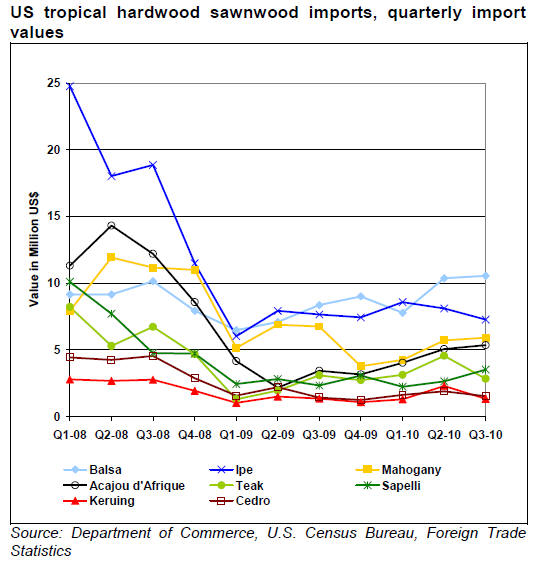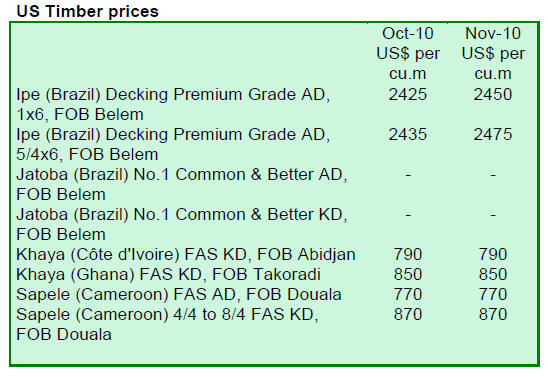|
Report
from
North America
US tropical timber imports
Sawn hardwood imports remain low
The value of sawn tropical hardwood imported into the US remains well
below the levels seen before 2009. The US imported US$49.1 million worth
of sawn tropical hardwood in the third quarter of 2010, up 2.4% from the
previous quarter and 19% increase from the same period in 2009, but 41%
below the third quarter of 2008. Ipe imports fell by 10.3% from the
second quarter, while imports of balsa, mahogany and acajou d’Afrique
saw a slight increase.
September imports of sawn tropical hardwood were 16,901 cu.m, down from
17,382 cu.m in August. The top three imported species were balsa (4,301
cu.m), ipe (1,776 cu.m) and mahogany (1,645 cu.m). Imports of most
species declined from August with the exception of ipe, keruing, red
meranti, cedro, virola and mahogany.
Year-to-date, import volumes of tropical sawnwood increased by 8% compared
with 2009. Among the species that gained significantly in the period to
September 2010 are jatoba (+84%), acajou d’Afrique (+60%), red meranti
(+44%) and keruing (+36%).
Hardwood plywood imports on the mend
US imports of hardwood plywood are set to exceed 2009 volumes, based on
year-to-date September imports of US$963 million, which is 36% above the
same period last year. China accounts for 55% (US$533 million) of total
imports year-to-date. In September 2010, imports from China were US$55.8
(+25% year-to-date) and from Indonesia US$17.6 million (+100%
year-to-date). September imports from Malaysia were US$8.6 million
(+167% year-to-date), from Ecuador US$2.9 million (+54% year-to-date),
and from Brazil US$1.6 million (+3% year-to-date).
Hardwood moulding imports continue to fall
Hardwood moulding imports declined again in September to US$16.3
million, a 5% drop from August. However, year-to-date imports increased
by 6% to US$140.1 million compared to the same period in 2009. China
increased shipments substantially from 2009. Imports from China were
US$5.5 million in September (+24% year-to-date). Brazil supplied US$4.4
million (-6% year-to-date), Malaysia US$1.3 million (+21% year-to-date)
and Indonesia US$946,000 (+32% year-to-date).
September imports from Brazil of jatoba moulding were US$2.5 million (-13%
year-to-date), of cumaru moulding US$296,000 (-11% year-to-date), and of
ipe moulding US$596,000 (-5% year-to-date). Supplies of cumaru mouldings
from Peru declined from August to US$215,000 (+329% year-to-date).
Mahogany moulding imports from Peru were just US$160,000 in September
(-17% year-to-date), compared with US$320,000 from Paraguay. Overall US
imports of cumaru moulding are up by 34%, while jatoba, ipe and mahogany
moulding imports are down compared to the same period last year.
Upswing in hardwood flooring imports
September hardwood flooring imports were the highest since June 2009.
Flooring imports remain far below levels seen in recent years, but the
upswing in September is mainly due to an increase in shipments from
Brazil and Malaysia, while imports from China and Canada declined.
Year-to-date September imports were US$12.3 million, down 39% compared
to the same period in 2009. Hardwood flooring imports from Brazil were
US$434,000 in September, up by 217% from August. Malaysia shipped
US$727,000 worth in September, up by 419% from August. On a year-to-date
basis, imports from Brazil are at the same level at last year, Malaysian
exports increased by 5% and Chinese exports to the US are down by 69%.



Hardwood resolution passed by US Senate
A resolution that recognises US hardwood products as a sustainable
resource was unanimously passed by the US Senate after having been
approved by the House of Representative last September. The resolution
identifies US hardwoods as a sustainable, abundant and legal resource.
It also recommends giving full consideration to US hardwoods in any
programme that promotes the construction of environmentally preferable
public, commercial or residential buildings.
AHEC commissions LCA study
The American Hardwood Export Council (AHEC) has commissioned a
consultant firm to conduct life cycle assessments (LCA) for American
hardwood species. AHEC announced that the study not only collects life
cycle inventory data on sawnwood, but also veneer and finished products
such as flooring, doors and furniture. The study will compare US
hardwoods with alternative materials in terms of environmental impact
and carbon footprint.
The LCA results will help manufacturers who rely on US hardwoods in
preparing Environmental Product Declarations (EPD) for their products in
line with international ISO standards. EPD is becoming an increasingly
important means to communicate the environmental performance of
products. Several green building initiatives, including LEED in the US,
use EPDs to evaluate the materials and products used in the building
sector.
Tropical sawnwood markets and prices
Demand for most species has reportedly slowed significantly since the
end of summer. Sales of jatoba, mahogany, acajou d’Afrique and sapelli
are down. Flooring manufacturers have reduced purchasing and demand from
the moulding and millwork sector remains subdued. Generally prices for
tropical sawnwood have remained stable from October. Availability of
tropical sawnwood is good with the exception of ipe. Ipe prices may
increase further as the Brazilian real is gaining strength. At the same
time the log supply situation to Brazilian mills remains tight.

Related News:
|